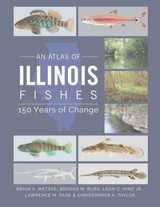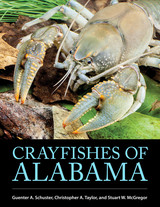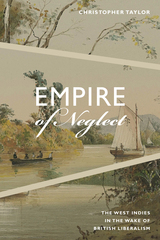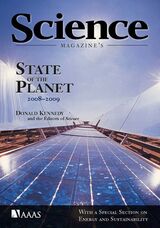4 books by Taylor, Chris

An Atlas of Illinois Fishes
150 Years of Change
Brian A. Metzke, Brooks M. Burr, Leon C. Hinz Jr., Lawrence M. Page, and Christopher A. Taylor
University of Illinois Press, 2022
Lake Michigan, winding creeks, sprawling swamps, and one of the world’s great rivers--Illinois’s variety of aquatic habitats makes the Prairie State home to a diverse array of fishes. The first book of its kind in over forty years, An Atlas of Illinois Fishes is a combination of nature guide and natural history. It provides readers with an authoritative resource based on the extensive biological data collected by scientists since the mid-1850s. Each of the entries on Illinois’s 217 current and extirpated fish species offers one or more color photographs; maps depicting distributions at three time periods; descriptions of identifying features; notes on habitat preference; and comments on distribution. In addition, the authors provide a pictorial key for identifying Illinois fishes.
Scientifically up-to-date and illustrated with over 240 color photos, An Atlas of Illinois Fishes is a benchmark in the study of Illinois’s ever-changing fish communities and the habitats that support them.
[more]

Crayfishes of Alabama
Guenter A. Schuster, Christopher A. Taylor, and Stuart W. McGregor
University of Alabama Press, 2022
A comprehensive assessment of the 99 known species of crayfishes inhabiting the state of Alabama
Crayfishes are common organisms in many freshwater habitats. They are usually the largest invertebrates and often represent the greatest amount of invertebrate biomass in their environments. Identified as a keystone species in many ecological communities, aquatic biologists are fond of saying “they eat everything, and everything eats them.”
Crayfishes—sometimes called crawfishes, crawdads, mudbugs, ditchbugs, yabbies, and flusskrebs—are taxonomically and ecologically a diverse group of aquatic crustaceans. There are more than 600 known species worldwide and North America alone is home to more than 400. As home to 99 documented species, Alabama is a global hotspot for crayfish diversity.
Crayfishes of Alabama is the first comprehensive reference work on the subject and provides the most up-to-date information on the vast range of crayfishes known to reside in Alabama. The authors have collected specimens and data from the state’s major and minor waterways and lakes, as well as specialized habitats such as burrows, caves, roadside ditches, marshes, swamps, and temporary autumnal ponds. This volume represents the most in-depth treatment of crayfishes found in the southeastern United States and offers detailed species accounts including descriptions of morphological characters, color, maximum size, comparative species, distribution and habitat, biology, crayfish associates, and conservation status. The species accounts are accentuated with color photographs, photographic morphological plates, and dot maps showing state and national distributions. A photographic key is provided to guide the identification of all 99 species.
Crayfishes are common organisms in many freshwater habitats. They are usually the largest invertebrates and often represent the greatest amount of invertebrate biomass in their environments. Identified as a keystone species in many ecological communities, aquatic biologists are fond of saying “they eat everything, and everything eats them.”
Crayfishes—sometimes called crawfishes, crawdads, mudbugs, ditchbugs, yabbies, and flusskrebs—are taxonomically and ecologically a diverse group of aquatic crustaceans. There are more than 600 known species worldwide and North America alone is home to more than 400. As home to 99 documented species, Alabama is a global hotspot for crayfish diversity.
Crayfishes of Alabama is the first comprehensive reference work on the subject and provides the most up-to-date information on the vast range of crayfishes known to reside in Alabama. The authors have collected specimens and data from the state’s major and minor waterways and lakes, as well as specialized habitats such as burrows, caves, roadside ditches, marshes, swamps, and temporary autumnal ponds. This volume represents the most in-depth treatment of crayfishes found in the southeastern United States and offers detailed species accounts including descriptions of morphological characters, color, maximum size, comparative species, distribution and habitat, biology, crayfish associates, and conservation status. The species accounts are accentuated with color photographs, photographic morphological plates, and dot maps showing state and national distributions. A photographic key is provided to guide the identification of all 99 species.
[more]

Empire of Neglect
The West Indies in the Wake of British Liberalism
Christopher Taylor
Duke University Press, 2018
Following the publication of Adam Smith’s The Wealth of Nations, nineteenth-century liberal economic thinkers insisted that a globally hegemonic Britain would profit only by abandoning the formal empire. British West Indians across the divides of race and class understood that, far from signaling an invitation to nationalist independence, this liberal economic discourse inaugurated a policy of imperial “neglect”—a way of ignoring the ties that obligated Britain to sustain the worlds of the empire’s distant fellow subjects. In Empire of Neglect Christopher Taylor examines this neglect’s cultural and literary ramifications, tracing how nineteenth-century British West Indians reoriented their affective, cultural, and political worlds toward the Americas as a response to the liberalization of the British Empire. Analyzing a wide array of sources, from plantation correspondence, political economy treatises, and novels to newspapers, socialist programs, and memoirs, Taylor shows how the Americas came to serve as a real and figurative site at which abandoned West Indians sought to imagine and invent postliberal forms of political subjecthood.
[more]

Science Magazine's State of the Planet 2008-2009
with a Special Section on Energy and Sustainability
Edited by Donald Kennedy and the Editors of Science
Island Press, 2009
Taken from the pages of Science and supplemented by contributions from the magazine’s editors, State of the Planet 2008-2009 offers contemporary science writing that is sometimes provocative, frequently enlightening, and always authoritative. Published by the American Association for the Advancement of Science (AAAS), Science is one of the most respected scientific magazines in the world. With a readership of more than one million people, it offers “hard science” from top scientists to both educated lay readers and scientists alike. The articles collected here are arranged thematically and each section is introduced by a prominent scientist or science writer. Donald Kennedy, who was Editor-in-Chief of Science when these articles appeared in the magazine, contributes a preface and several short essays. Focusing on issues of energy and sustainability, sections of the volume are devoted to the prospects of energy-sparing technologies and alternatives to fossil fuel use, including ethanol and cellulosic digestion. Other sections center on climate change, led by a comprehensive essay on the state of scientific knowledge today and followed by contributions about the Antarctic and Greenland ice sheets, as well as the effects of climate change that have been measured to date, including changes in migration and breeding cycles of birds and flowering in plants, changing patterns of hurricanes and extreme weather events, and alterations in forest fire frequency. Interspersed throughout the book are Science news pieces that highlight particular issues and cases relevant to the main scientific findings. A glossary of key terms and concepts helps students and nonspecialists better understand the terminology and the issues.
[more]
READERS
Browse our collection.
PUBLISHERS
See BiblioVault's publisher services.
STUDENT SERVICES
Files for college accessibility offices.
UChicago Accessibility Resources
home | accessibility | search | about | contact us
BiblioVault ® 2001 - 2024
The University of Chicago Press









